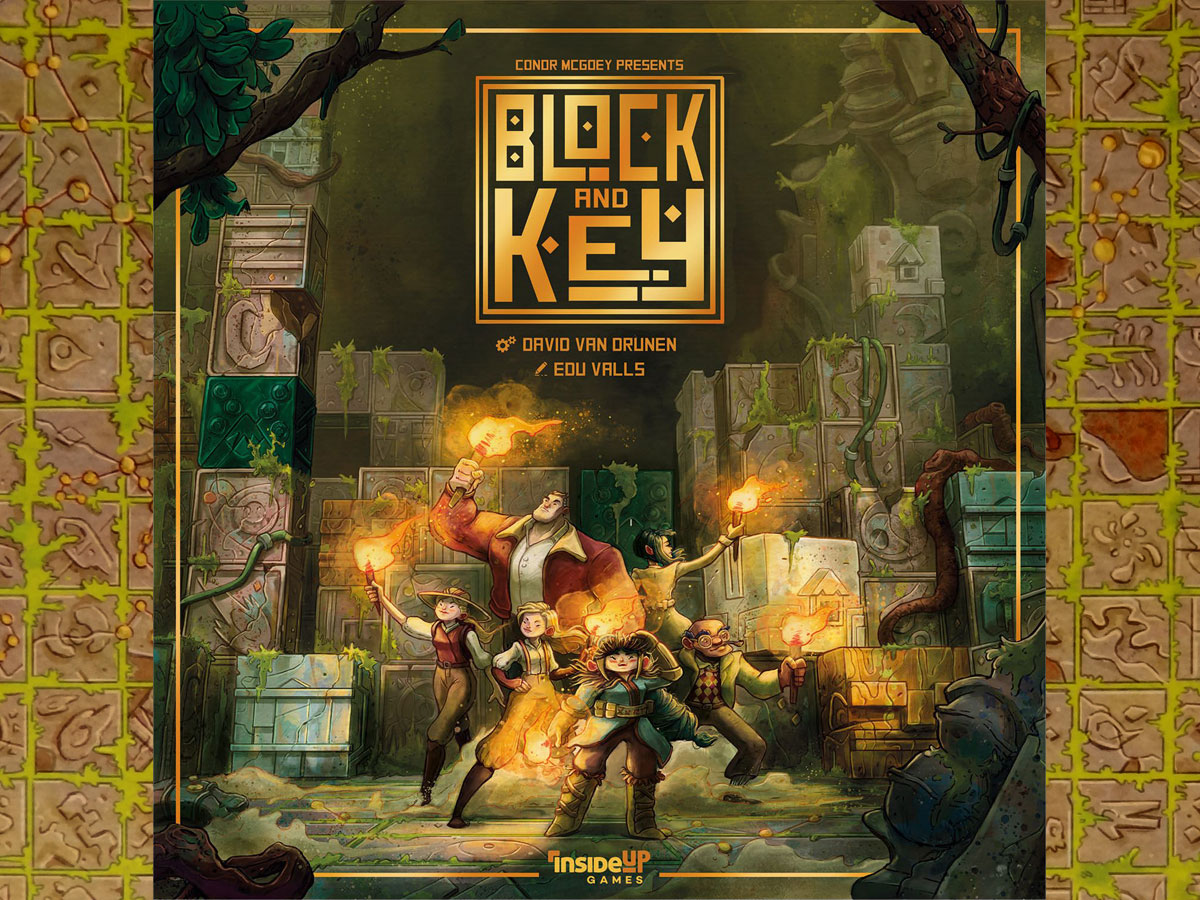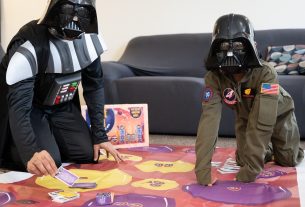You’ve discovered some ancient ruins … perhaps built by aliens? Reassemble key structures to unlock the mystery.
What Is Block and Key?
Block and Key is a block-placing game for 1 to 4 players, ages 8 and up, and takes about 20–40 minutes to play. It’s currently seeking funding on Kickstarter, with a pledge level of $54 CAD (about $42 USD) plus shipping for a copy of the game. The game is family-friendly and the main limitation would be whether your kid is tall enough to reach the top of the “ruins” to place blocks.
Block and Key was designed by David Van Drunen and published by Inside Up Games, with illustrations by Edu Valls.
New to Kickstarter? Check out our crowdfunding primer.
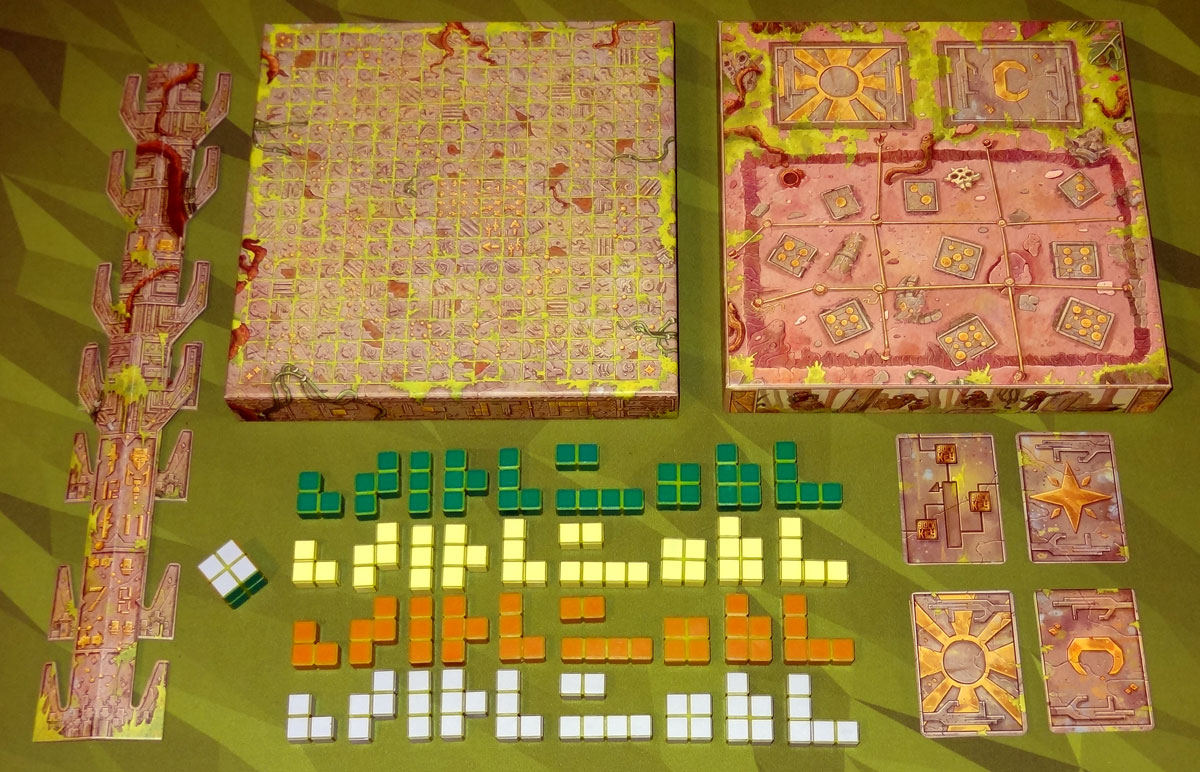
Block and Key Components
Note: My review is based on a prototype copy, so it is subject to change and may not reflect final component quality, and stretch goals may add other components or upgrade existing ones. One difference in particular is the color of the “white” blocks, which appear a light green in the prototype, an issue that they’re working on fixing.
Here’s what comes in the game:
- Game box
- 4 Support Columns
- Core Cube
- 40 Clay Blocks (4 colors each of 10 shapes)
- 4 Enigma cards
- 8 Star Key cards
- 24 Sun Key cards
- 16 Moon Key cards
- Cloth bag (not pictured)
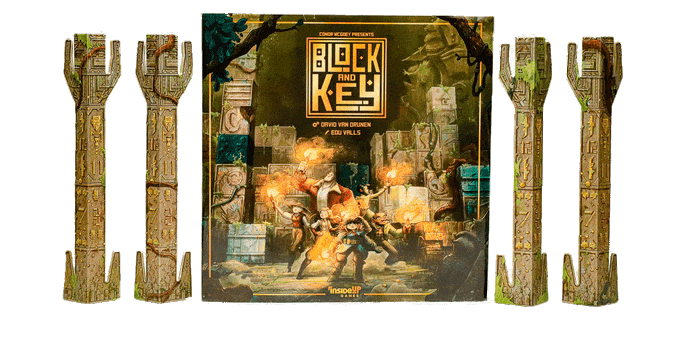
Normally I don’t list the box as a game component, but in this instance the box itself is used as part of the game setup: after removing the sleeve from the box, you attach the box bottom and top to the supports to build the “ruins,” a two-story structure. The bottom of the ruins holds the key cards and the excavation site, and the top is where the blocks will be placed during the course of the game.
The supports fit on the corners using the prongs, and the structure itself is sturdy enough, though you definitely don’t want your kids leaning on it too much. The illustrations and markings on the sides aren’t just decorative—they’re actually some reminders about gameplay, disguised as hieroglyphics. I did wonder how well the prongs will hold up with repeated use; they get a little bent when you set up the board, so I don’t know if they’ll break or tear eventually. They’re pretty thick cardboard, though.
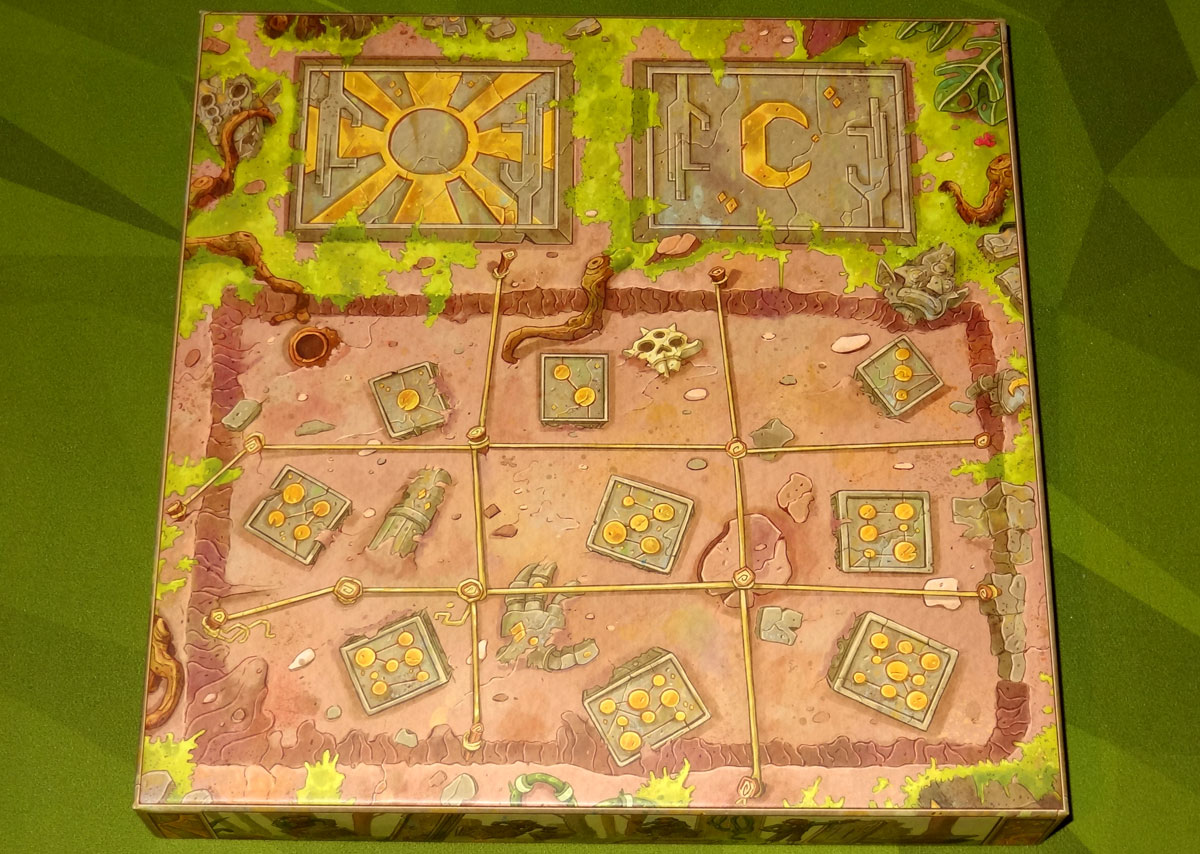
The illustrations are made to look like some sort of ancient ruins of ambiguous origin, with some hints of extraterrestrial influence (note the strange skull on the bottom of the box). I had a draft version of the rulebook that didn’t really provide any narrative or theme, but I’ve been told by the publisher that this wasn’t intended to represent any actual culture specifically, and instead was some sort of alien civilization. (Fortunately for us, they happened to use Arabic numerals.)
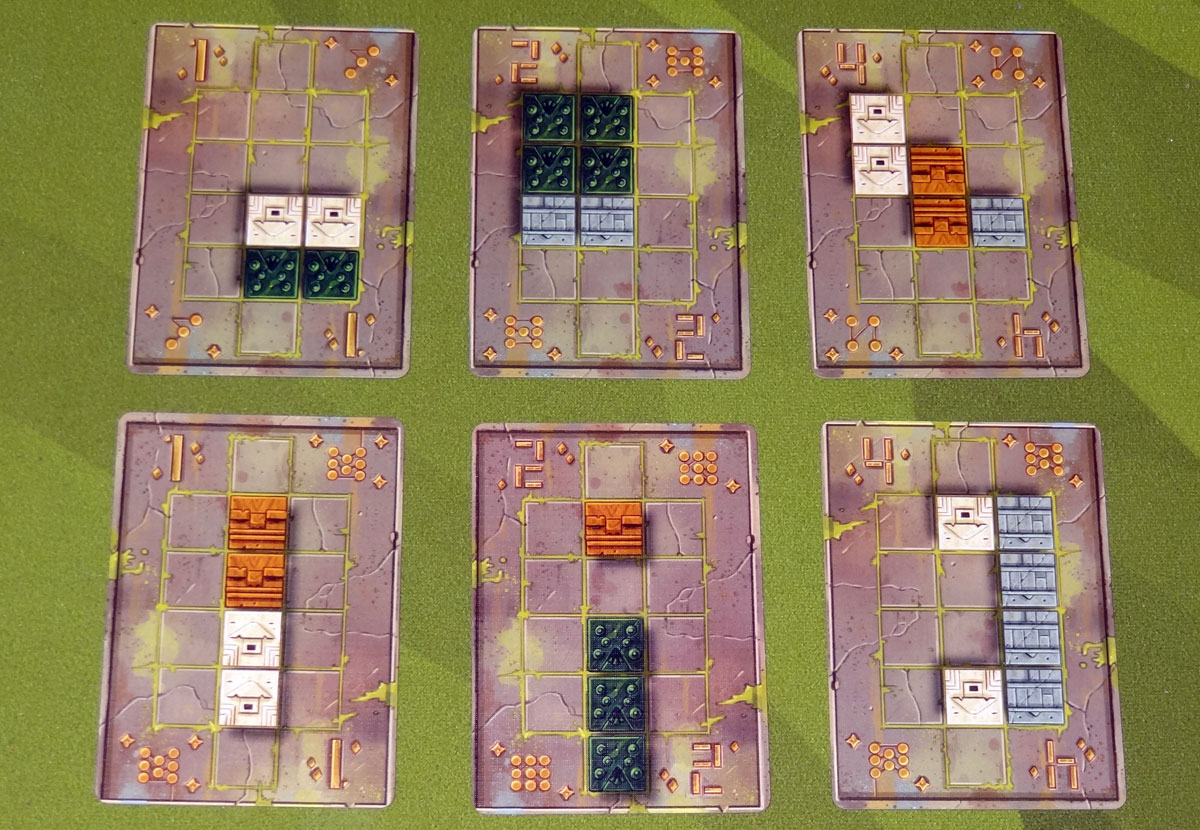
The key cards show various patterns of squares; the squares on the cards are illustrated to look like carvings, which also helps with distinguishing the colors from each other, though the four colors chosen (white, gray, brown, green) should be fairly distinctive anyway. There are some additional markings—the pips and stars—that are used for solo play.

The blocks themselves are clay, giving them a nice weight. There are four different colors, and the green core is intended to evoke moss and vines. The core cube has all four colors on its faces. The blocks are fun to handle, and my daughter enjoyed making various structures out of them even apart from playing the game.
The prototype didn’t include the cloth bag, but there will be an embroidered bag of some sort for the blocks in the finished game. I used a large plastic bag that was included, and just held it under the table while drawing pieces out of it.
How to Play Block and Key
You can download a draft of the rulebook here.
The Goal
The goal of the game is to score the most points by completing keys.

Setup
Assemble the ruins structure. Put all of the blocks (except the core cube) in the bag and mix them up. On the bottom portion, place the sun and moon cards, and fill the 9 spaces of the excavation site with random blocks drawn from the bag.
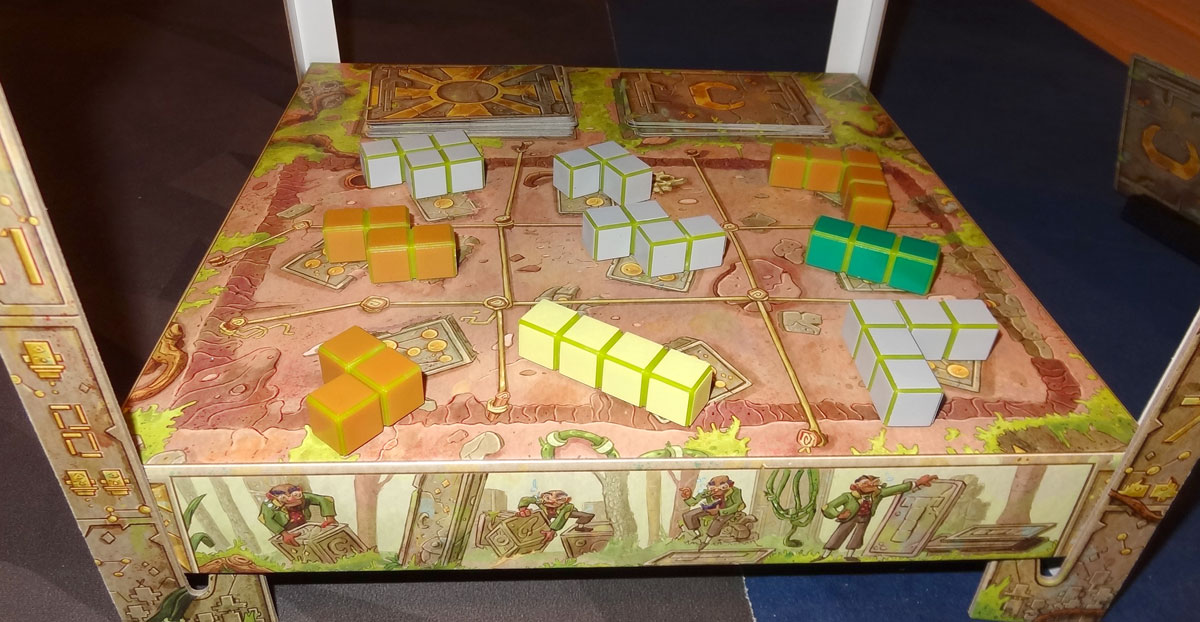
Give each player 2 star cards, 1 sun card, 1 moon card, and 1 enigma card. These are to be kept secret from other players. (Any remaining star or enigma cards are returned to the box.)
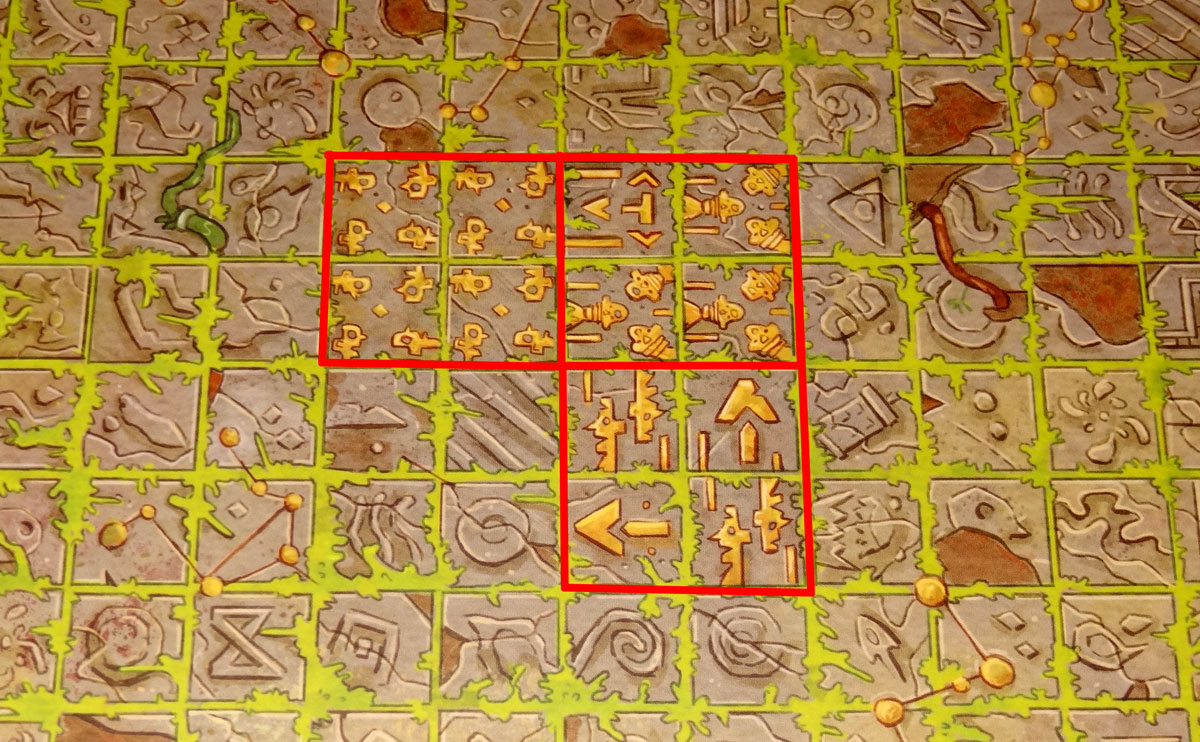
Choose a starting player. The starting player places the core cube on the designated space (note the number of heads for player count) with a brown side facing up. The gold arrows indicate the sides of the ruins where players should sit. In reverse turn order, each player gets to take three blocks: you must take either a row or a column from the grid, and then the spaces are refilled randomly from the bag. Now the game is ready to begin.

Gameplay
On your turn, you may either excavate blocks or place a block.
To excavate, simply take a row or column of blocks from the excavation site, and then refill the site by drawing blocks from the bag. You may have a maximum of 7 blocks in your supply; if you go over, discard extras into the bag. (If the bag runs out, refill the excavation site as much as possible, and players might get fewer than 3 blocks when they excavate.)
When you place a block, there are a few rules you have to obey. A block may be placed if at least a corner of the block touches the corner of an existing block. If any faces are touching, your block must be taller than the highest point of the stack that it touches. Blocks may be stacked up to 6 faces high, and while you can create a straight bridge, you cannot make any unsupported overhangs.
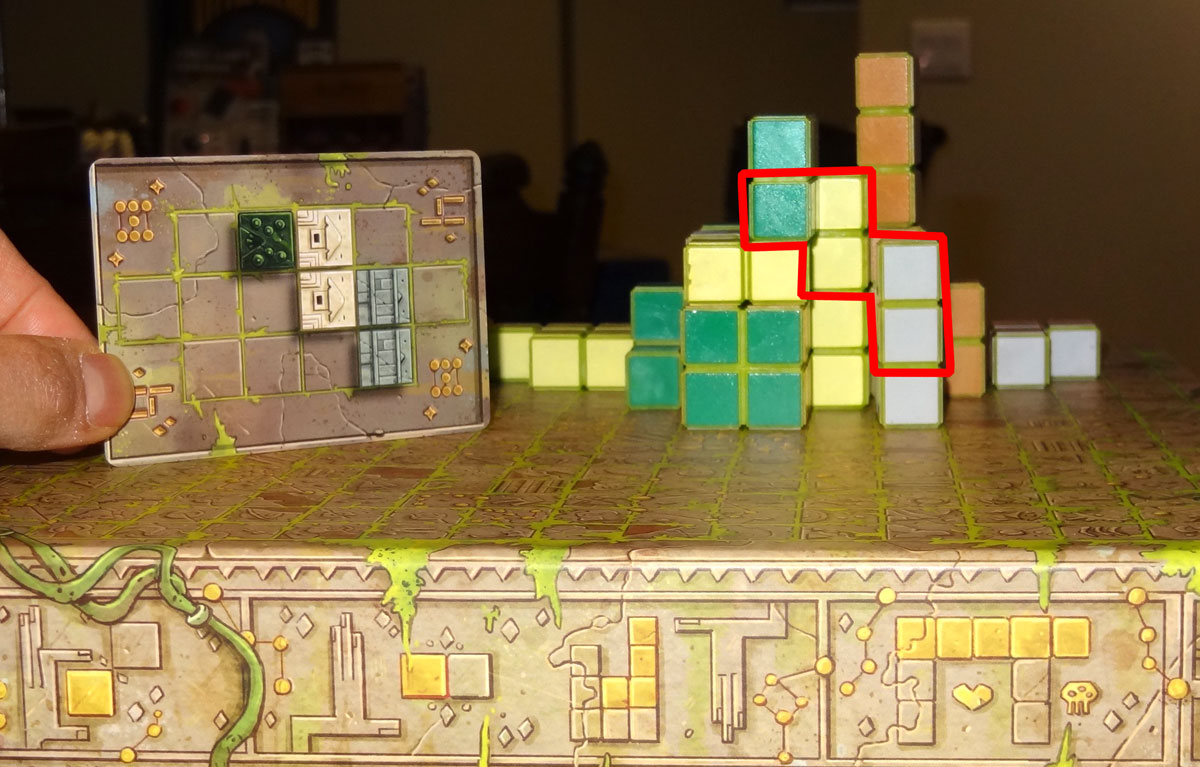
As you place blocks, your goal is to complete your key cards by creating the depicted pattern, as seen from your perspective. Empty spaces on your key card may be empty or occupied by any color blocks, and you can rotate the card in any orientation (but you can’t mirror the pattern). You may complete multiple key cards in one turn, but each card completed must use at least one face from the block you placed this turn. Other players can come look at the board from your point of view to confirm that you’ve matched the pattern, but otherwise players should only be looking at the ruins from their own side.
Place completed key cards face-up in front of you, and then draw back up to 4 cards at the end of your turn. You may draw from the sun or the moon stacks. Your two starting star cards are the easiest (worth 1 point), sun cards are medium (2 points), and moon cards are the hardest (4 points).
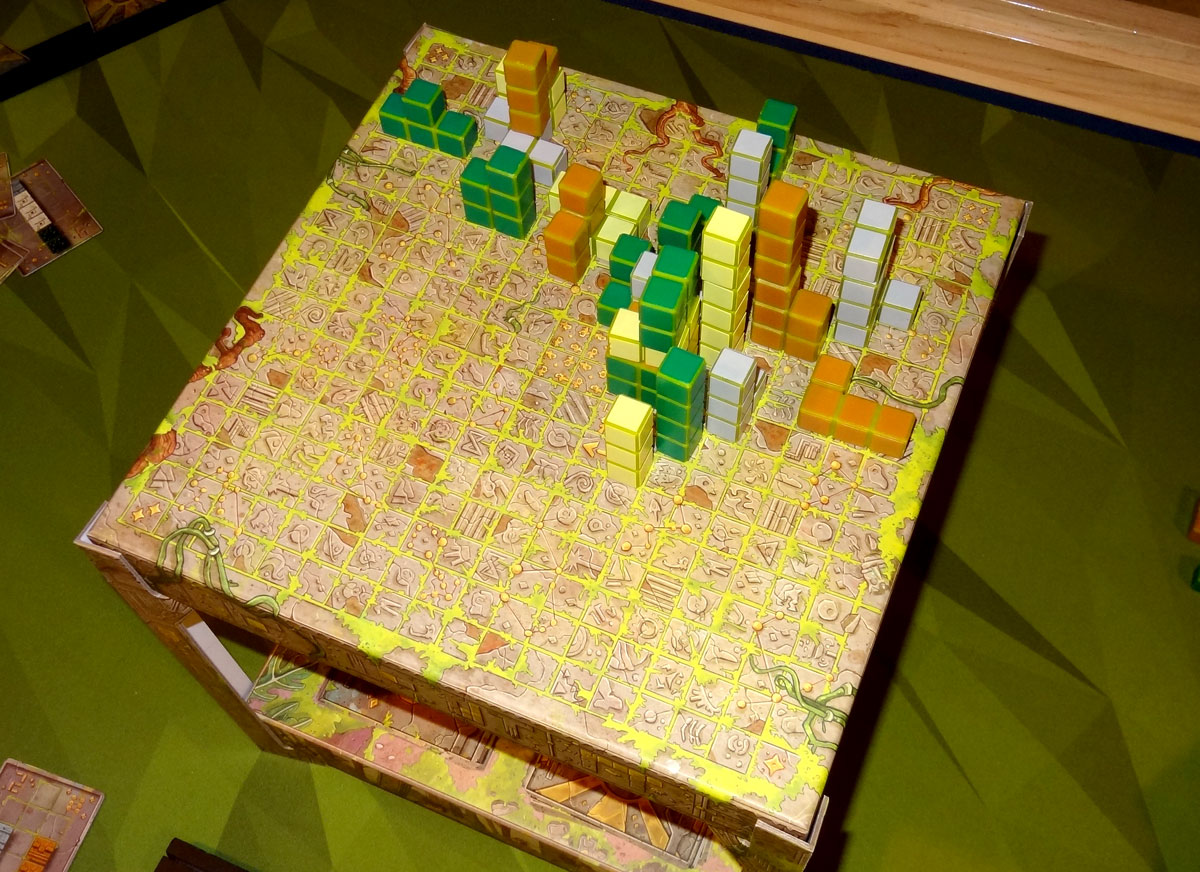
Game End
The game end is triggered when a player has completed a set number of cards: 12 for 2 players, 8 for 3 players, 7 for 4 players. (These numbers are also on the support columns as a reminder.) Each player gets one more turn, and then scores are added up.
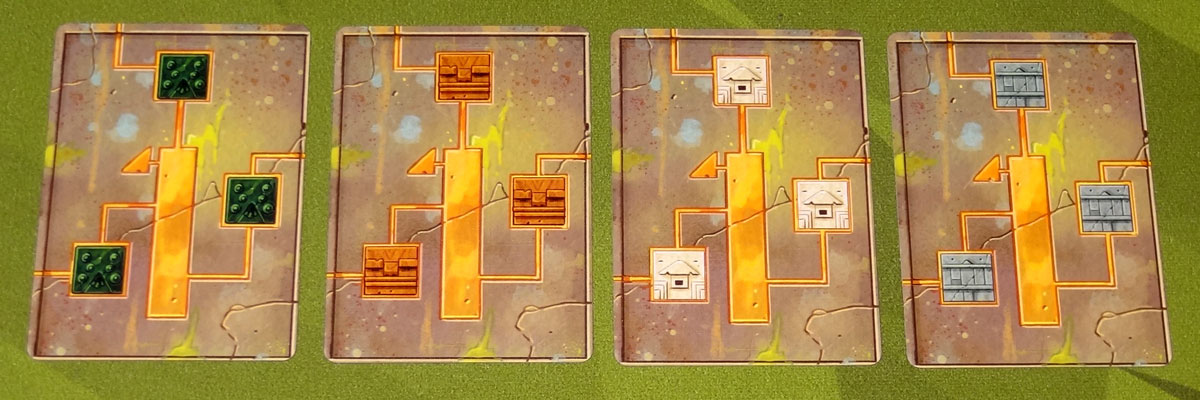
In addition to your completed key cards, you also score points for your enigma card. For every 3 faces of the indicated color that you can see from your perspective, you score 1 point.
The player with the most points wins, with ties going to the player who completed the most key cards, and then the player earlier in turn order.

Solo Mode
Solo play is similar, played against an automated opponent. You set up using the 4-player location, and you’ll have 11 turns to score as many points as possible. Your turns are the same as before—take blocks or place a block—but you’re also allowed to discard 1 key from your hand to draw a replacement at the end of your turn.
If, on your turn, you have drawn at least 1 key card, then the opponent gets a turn. Look at the icons on the last key card you drew: there are a number of pips and stars. The pips indicate which of the nine blocks will be taken from the excavation site, and the stars show where it should be placed.
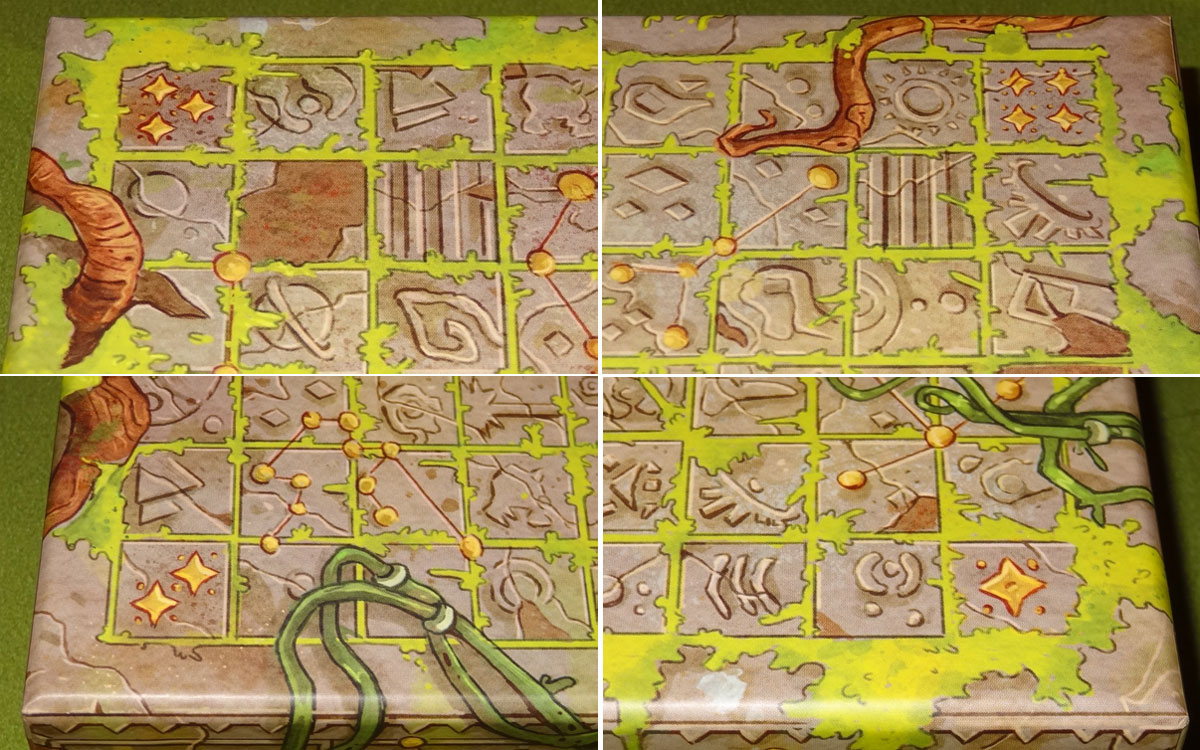
Each corner of the board is marked with 1 to 4 stars. You must place the block corner-to-corner with the cube that is closest to the indicated corner of the board. You’re allowed to choose the orientation of the block, as long as it fits. If there’s no way to place a block there, then the block is just returned to the bag.
After you’ve taken 11 turns, add up your key cards and your enigma points, and compare your score to the chart to see how you fared, from Trainee to Expert Archaeologist.
Why You Should Play Block and Key
Block and Key is the sort of game that will appeal to players who like spatial reasoning puzzles. It reminds me a little of La Boca, an older game in which two players had to build a structure together but could only see the goal from their perspective, or the more recent Mental Blocks that increased the number of players building together but also threw in some restrictions for each player. The thing these games have in common is perspective: you’re trying to build structures to match a particular point of view, while other players are also adding to the same shared structure.
Since you can rotate your key cards, one trick is figuring out the best way to build out the pattern. Easier cards can often be handled with just two blocks—perhaps one color is already out on the board, so you just add another block and complete it. But more difficult patterns may involve weird step shapes, or be in a long line—is it easier to stack things to create that pattern, or lay them out horizontally? While other players might place blocks that also help you, I like that you must include your most recent block in each key: there are no free passes here!

I got to play a few times (including a solo game) before I had to ship the prototype along, but I really enjoyed it. I like games about building things and making patterns, so this game hit a sweet spot for me. The execution of the idea was also fantastic: the raised playing surface isn’t just a gimmick, but actually helps you to look at the structure from the right angle without having to duck your head down to the table. It might be a little trickier to play a 4-player game at a rectangular table, though. (We shifted to the end of the game table for a 3-player game.)
One strategy tip we figured out is that you generally want to build in a direction away from you, because then it’s possible to cover things up later. But if you build toward yourself from the start, eventually you run out of room on the board and it’s much harder to place blocks that you can still see from your perspective. I did find that stacking was less common than I’d expected, largely because of the rules about having to be taller than anything you’re touching, so the corner-to-corner placement was more common.
Another choice you have to make is which cards to attempt (and which stack to draw from when you’re refilling your hand). The moon cards are worth 4 points each, but it can take you a lot longer to complete them. Since the game end is triggered by a certain number of cards, you don’t want to use them all up with low-point cards … unless you can outpace everyone else and end the game before they get their high-scoring cards completed.

The interaction in Block and Key is mostly indirect, or at least often unintentional. Obviously if you take a block from the excavation site, somebody else might have wanted it—but since key cards are hidden information, there’s no way for you to know which blocks are going to help another player. Likewise, if you place a block, you have no idea whether it will help somebody complete their key card or make it harder. Of course, if you place a block so that it’s between a player and the last block they played, there’s a good chance you’re messing something up, but even that can be a gamble. I do wonder what it would be like to play with all the key cards face-up—would it make it more cutthroat, or would it just lead to analysis paralysis? (Maybe something I’ll have to revisit when the game is finished.)
The solo game is fun and still gives you a lot of the same feel, though you do get a bit more control over your opponent’s pieces than you would in a 2-player game. The scoring levels are challenging: the highest tier is 33+ points, which means you must score an average of 3 points per turn (and that even counts turns in which you took blocks). So you have to score a good number of moon cards, or manage to complete multiple cards on a few turns, to hit that level.
One potential issue I could see is that drawing different-sized blocks from a bag isn’t totally random. I did my best not to feel around for specific blocks while pulling them from the bag, but it’s certainly easy to tell pieces apart even unintentionally. While you can’t distinguish colors, you could certainly tilt the balance in favor of small pieces or large pieces if you wanted to—and it’s easy for small pieces to jumble together at the bottom of the bag so that large pieces get drawn first. I’m not sure how to solve that problem: a deck of cards would work, but also make it a lot more fiddly. The best solution may just be to play with people you trust aren’t going to cheat.
I also wished for a little more explanation of the theme itself, though that may still be coming because I only had a draft rulebook. Sure, the general theme is archaeologists discovering a mysterious site with some evidence of aliens … and then what? While the gameplay is perfectly fine as an abstract with no narrative, the illustrations actually make me want more answers.
My kids and I enjoyed Block and Key, and it’s one I would recommend for puzzle-lovers and fans of building stuff. The clay blocks provide a nice tactile play, with a weight that wooden or plastic pieces can’t match. The two-tiered board is a nice touch that elevates (ahem) this game to new heights—important for a game where your perspective matters.
For more information or to make a pledge, visit the Block and Key Kickstarter page!
Click here to see all our tabletop game reviews.
![]() To subscribe to GeekDad’s tabletop gaming coverage, please copy this link and add it to your RSS reader.
To subscribe to GeekDad’s tabletop gaming coverage, please copy this link and add it to your RSS reader.
Disclosure: GeekDad was loaned a prototype of this game for review purposes.
